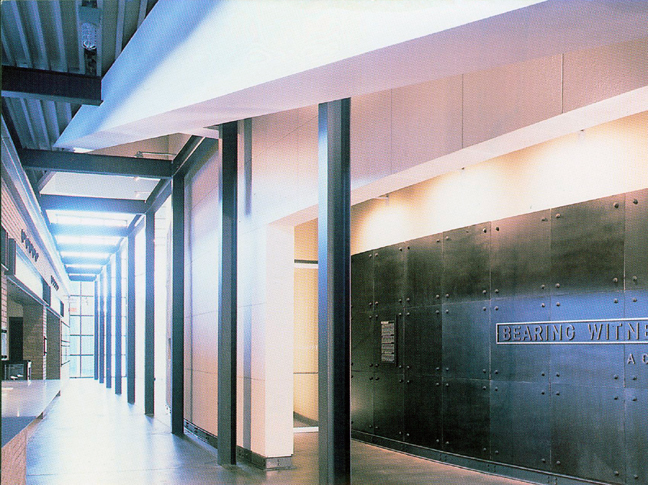

As I approach the large glass doors it strikes me as symbolic that for this part of the exhibit you can see what's coming up ahead. This is the last time this is true for the exhibit, as in the next sections visitors are forced around corners to immediately confront things they may not expect. This seem to be symbolic of the whole build up towards Nazi Germany. From afar, people could see it coming as if through glass doors, but as they got closer and finally passed through the doors, it was too late to turn around and leave, but had to continue turning corners to find surprises they couldn't even imagine. Once inside the doors, the first thing I encounter is a large glass display on the right built into the wall. Inside it displays several tradition Jewish artifacts such as the torah, prayer shawls (talis), Hanukah menorah, and prayer books. Captions on the glass contextualize the objects and describe their use, while a few feet further down the wall a display reads, "Keeping Traditions: Jewish Origins and the Diaspora".
This part of the exhibit is characterized by high ceilings, light grey walls, and small, opaque widows letting in more light than can be found in the rest of the exhibit. Along the left wall, from the floor to the high ceilings, are large family portrait style photographs of various European Jewery. Most contain no captions but feature Jewish Europeans of all ages and sexes, both pictured alone and together as families. Superimposed between the pictures are various family trees showing the geneology of several European Jewish families over several generations. Farther down the right side of the wall is a large, color coded world map taking up almost the entire wall. The map is part of the "Jewish Diaspora" display and features pictures of Jewish religious artifacts found in various places across the map in vastly different time periods.

This first part of the hall seems to serve what many people have found to be an absence in Israel's and the US's national Holocaust museums. My research on other Holocaust Museums found that complaints are often made that they fail to contextualize Jewish life in Europe before the rise of Nazi power. There are frequently complaints and fears the people will leave such museums no wiser to the power of discrimination, but rather thinking that the Jews were somehow "destined" for the Holocaust. A proper understanding of Jewish culture and life before the Holocaust is essential to understanding that it can happen to anyone. The images of Jewish life before the Holocaust serve to personalize the victims to be more than 1 of 6 million victims. In viewing these images, I began to compare them to similar style pictures of my family and imagine them up on the wall. The pictures serve to contextualize the visitor within the context of a Jew in Germany and begin to imbue them with the feeling of "experiencing" the Holocaust. As Geoffrey Short points out of a different museum, "A misconception, and one that the museum planners were especially keen to avoid was the view of Jewish history as synonymous with persecution" (Short 15). For this reason as well, a discussion of Jewish culture before the Holocaust is essential.
This particular hall also addresses another main complaint against other museums; that they often begin their discussion of anti-Semitism with Germany in the 1880s. In the Houston museum, the large map display of the Jewish Diaspora is superimposed on the bottom by a timeline of Anti-Semitism which starts with Spain in the year 306 and continues through France, Italy, Germany, and Switzerland before reaching Germany in 1881. Overhead, about 20 feet in the air, a large black screen displays one of the museum's core messages, "It happened. Therefore it can happen again: This is the core of what we have to say" a quote by Primo Levi. Just passed here, the hall ends with a large display tablet reading, "Loss of civil liberties: Third Reich targets the Jews". Protruding from the display, a glass display case houses the first English translation of Hitler's book, "Mein Kampf" or "My Struggle". Through the glass display case I can almost feel the aged texture of the book, visible along the edges and binding. This display symbolizes the beginning of the end for the German Jews.